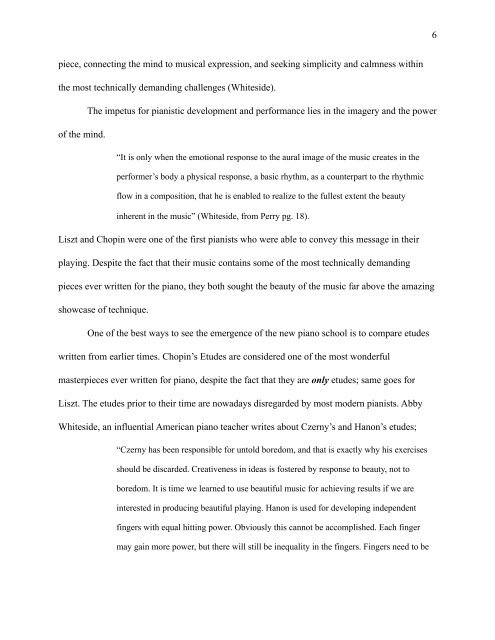Click here for the (pdf) - Michael Kravchuk
Click here for the (pdf) - Michael Kravchuk
Click here for the (pdf) - Michael Kravchuk
Create successful ePaper yourself
Turn your PDF publications into a flip-book with our unique Google optimized e-Paper software.
piece, connecting <strong>the</strong> mind to musical expression, and seeking simplicity and calmness within<br />
<strong>the</strong> most technically demanding challenges (Whiteside).<br />
of <strong>the</strong> mind.<br />
The impetus <strong>for</strong> pianistic development and per<strong>for</strong>mance lies in <strong>the</strong> imagery and <strong>the</strong> power<br />
“It is only when <strong>the</strong> emotional response to <strong>the</strong> aural image of <strong>the</strong> music creates in <strong>the</strong><br />
per<strong>for</strong>mer’s body a physical response, a basic rhythm, as a counterpart to <strong>the</strong> rhythmic<br />
flow in a composition, that he is enabled to realize to <strong>the</strong> fullest extent <strong>the</strong> beauty<br />
in<strong>here</strong>nt in <strong>the</strong> music” (Whiteside, from Perry pg. 18).<br />
Liszt and Chopin were one of <strong>the</strong> first pianists who were able to convey this message in <strong>the</strong>ir<br />
playing. Despite <strong>the</strong> fact that <strong>the</strong>ir music contains some of <strong>the</strong> most technically demanding<br />
pieces ever written <strong>for</strong> <strong>the</strong> piano, <strong>the</strong>y both sought <strong>the</strong> beauty of <strong>the</strong> music far above <strong>the</strong> amazing<br />
showcase of technique.<br />
One of <strong>the</strong> best ways to see <strong>the</strong> emergence of <strong>the</strong> new piano school is to compare etudes<br />
written from earlier times. Chopin’s Etudes are considered one of <strong>the</strong> most wonderful<br />
masterpieces ever written <strong>for</strong> piano, despite <strong>the</strong> fact that <strong>the</strong>y are only etudes; same goes <strong>for</strong><br />
Liszt. The etudes prior to <strong>the</strong>ir time are nowadays disregarded by most modern pianists. Abby<br />
Whiteside, an influential American piano teacher writes about Czerny’s and Hanon’s etudes;<br />
“Czerny has been responsible <strong>for</strong> untold boredom, and that is exactly why his exercises<br />
should be discarded. Creativeness in ideas is fostered by response to beauty, not to<br />
boredom. It is time we learned to use beautiful music <strong>for</strong> achieving results if we are<br />
interested in producing beautiful playing. Hanon is used <strong>for</strong> developing independent<br />
fingers with equal hitting power. Obviously this cannot be accomplished. Each finger<br />
may gain more power, but t<strong>here</strong> will still be inequality in <strong>the</strong> fingers. Fingers need to be<br />
6


